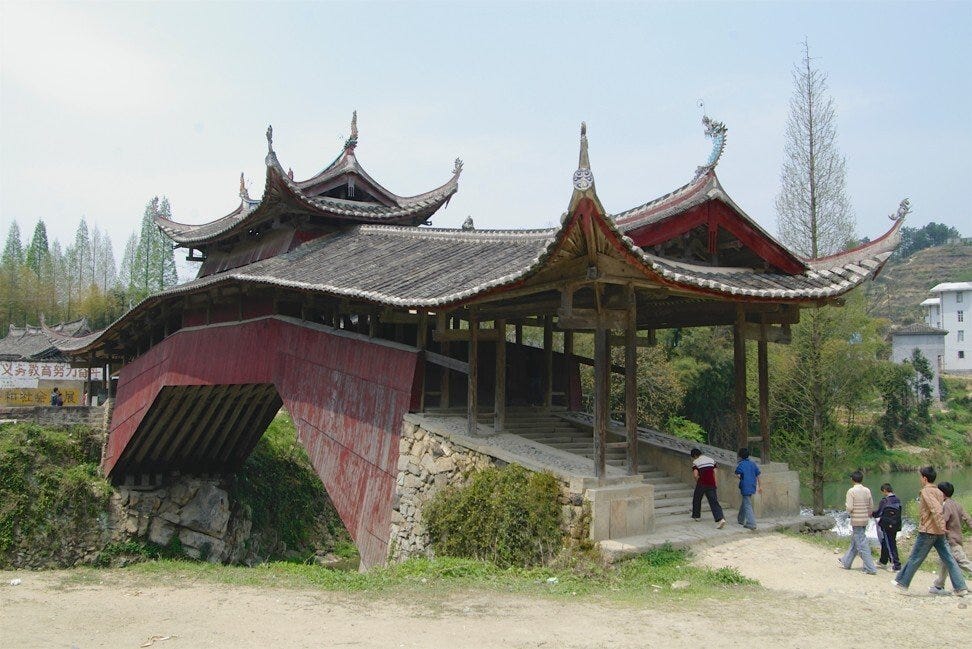If we in the West are to have a meaningful chance of coexisting peacefully with the Chinese, it is imperative that we understand China. This is not so simple as merely understanding the history and culture, important though these be. We need to appreciate how the Chinese think because that influences how they act, just as the same holds true for us. In addition, after linking to an article by Professor Ronald Knapp about corridor bridges in China in the last issue, this month I explore China’s long tradition of such bridges.
Understanding China
The world has been trying to understand China for more than a millennium. Misunderstanding has most often been the order of the day, decade, century. Libraries have been written on the topic.
How and what do the Chinese think? When and why do they act? Is China fundamentally different than the West? Will China change? Should China change? When will China change?
What is the key to understanding? If I had an absolute answer, I would be a very popular person. This does not mean, though, that we should not strive to figure out what makes the other tick, just as they assuredly want to know what makes us tick. In answering the first question, we may glimpse an answer to the second.
In this regard, I think of Star Trek. Gene Roddenberry had a genius for tackling significant issues in a relatable manner. In “Darmok” (TNG, Season 5, Episode 2), Captain Picard and Captain Dathon, a Tamarian, are transported to the surface of El-Adrel IV (am I the only one who wonders how all of the planets they visit have breathable Class M atmospheres?). There are no civilizations on the planet, but there is a dangerous creature that wants to do them harm. Neither captain can communicate with the other. They do not have a common language, and the universal translator is no help.
As their fight to survive intensifies, as the two struggle with a common foe, the fog slowly lifts, and Captain Picard finally realizes that his counterpart frames his world, understands his surroundings, and therefore communicates in a fashion so very different from his own. This realization comes after great effort and at great cost. The Tamarian view and characterize life and their actions in relation to their species’ unique history and mythology. Specifically, they do not speak directly. They do not use a clear-cut language of letters, words, and sentences to express ideas as their principal vehicle of communication and understanding. Rather, they rely on metaphor, allegory, and storytelling to paint a picture that conveys intent and meaning.
I thought of this again as I recently read Tim Clissold’s 2014 book, Chinese Rules. While I am not suggesting that Chinese society and the Tamarian society are the same, the challenges that Captain Picard faced and his ability, at the end of the ordeal, to understand, work with, and honor Captain Dathon can be instructive.
Mr. Clissold’s rules for understanding China and the Chinese are based on his business and cultural experiences in China. The rules are indeed instructive, maybe even more so since China has continued to strengthen as the Xi Jinping era has developed (the book was published during the first two years of his reign). If we strip away politics as the principal lens through which to analyze the other, presuming that this is even possible on either side, these are the five rules:
Rule 1 — “China has its own set of uniquely Chinese rules.” These rules “…are more elusive than ours; they come from accepted modes of thought and unspoken assumptions rather than concise written commandments….”
Rule 2 — “China’s historical experience has left its people with an intense dread of instability. China is not so tightly bound together by anything more than a common acceptance of its Chineseness. Officials seek stability above all else and this drives policy in every corner of China’s vast bureaucracy.”
Rule 3 — “China’s methods for dealing with conflict and competition are indirect. The traditional Chinese method is to bide time—for decades if necessary—until external factors are favorable, use spies and counterspies to gather information, disrupt the enemy’s alliances, sow discord among his followers, frustrate his strategies, and use the strength of another.”
Rule 4 — “The Chinese have a deep tradition of pragmatic realism rather than fixed, value-based rules….” “This [ancient] emphasis on practice-based investigation rather than rigid rules makes the Chinese some of the most flexible people on earth.”
Rule 5 — Sunzi’s Art of War: “Know yourself and know the other and you’ll survive a hundred battles.”
As Mr. Clissold admonishes, railing against the above and complaining that they are unfair and not our way is a sure way to get a headache as we continue pounding our heads against a wall. We do not have to like the rules and we do not need to accept the rules, but we definitely need to understand them so that our international dealings with the Chinese can be as fruitful as possible. If we understand who we are dealing with and how they approach economics, politics, the military, as well as social and cultural affairs, the odds of being able to find common ground and achieve peaceful co-existence become much, much more favorable. Compromise is a two-way street; understanding is a roadmap.1
Chinese Corridor Bridges
Covered bridges in America and Europe have long fascinated people. I count myself as one. This is a minute-long video I shot walking through the Des Rivieres Bridge across the Pike River in Quebec, Canada. A bridge has spanned the river since about 1840. This bridge was built in 1913. Since discovering this bridge in 2018, I have learned that China has a much longer and more involved tradition of covered bridges.
Professor Ronald Knapp and Peter Neville-Hadley are two who have explored, studied, and shared this Chinese tradition with the West.
Chinese corridor bridges number in the several thousands (and presumably many more in the far past). With a history stretching back up to 2000 years, Zhejiang and Fujian Provinces were fertile ground for corridor bridges, but such bridges have been found in several provinces throughout southern and southwestern China. In just one remote mountainous county in Zhejiang, Professor Knapp writes that “958 bridges of various types were counted in 1987” (Knapp, Chinese Bridges, Page 219).
Means of construction are varied. Some bridges are short, some long. Some are soaring, some simple. Arches, cantilevers, trusses. Innovative timber substructures. Corridor bridges have been analogized to buildings, both in terms of construction methodologies and uses. They were not designed for motor vehicles. Yes, the bridges were used to transport products and to get from place to place high in the mountains and to villages and towns, but they were also community centers where people gathered to rest, share information, worship.
If the bridge types sound melodic--rainbow bridges, centipede bridges, wind and rain bridges, the names of bridges themselves could be even more expressive--Passage of the Immortals Bridge, Mythical Bird Peak Bridge, and Like a Dragon Bridge.
Covered bridges have become chic in China. Not only is tourism booming for ancient examples of such bridges, but new bridges are being constructed with traditional methods in a sort of tourist status chase. The beauty and mystique of such structures makes it obvious why.2
China Resources
Following up a recent article I wrote about anti-Asian discrimination in America, actress Lucy Liu wrote this opinion piece about combating Asian stereotypes.
Follow Andrew Singer on Social Media: Instagram, Facebook, Twitter.
"Understanding China" -- Photographs by Zhimai Zhang (Unsplash) and Chastagner Thierry (Unsplash)
"Chinese Corridor Bridges" -- Photographs by Peter Neville-Hadley and Difa Gong (substructure picture)










